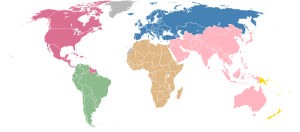Supercopa Libertadores: Difference between revisions
No edit summary |
|||
| Line 21: | Line 21: | ||
Every round of the competition is contested over a [[two-legged tie]]. The teams accumulate points as per the results of the match (3 for a win, 1 for a draw, 0 for a loss). The team with the most points after both legs wins the series. Unlike European club competitions, South America historically did not use [[extra time]] to decide a tie that was level on aggregate. Ties in points would be broken first by goal difference, then by [[Away goals rule|away goals]], and lastly by a [[Penalty shootout (association football)|penalty shootout]] after regulation of the second leg. |
Every round of the competition is contested over a [[two-legged tie]]. The teams accumulate points as per the results of the match (3 for a win, 1 for a draw, 0 for a loss). The team with the most points after both legs wins the series. Unlike European club competitions, South America historically did not use [[extra time]] to decide a tie that was level on aggregate. Ties in points would be broken first by goal difference, then by [[Away goals rule|away goals]], and lastly by a [[Penalty shootout (association football)|penalty shootout]] after regulation of the second leg. |
||
== Records and statistics == |
|||
{{Main|Records and statistics of the Supercopa Sudamericana}} |
|||
==See also== |
==See also== |
||
Revision as of 18:12, 27 August 2010
| File:Supercopalogo.PNG | |
| Founded | 1988 |
|---|---|
| Region | South America (CONMEBOL) |
| Number of teams | Varied per year |
| Most successful club(s) | (2 titles each) |
Supercopa Sudamericana (English: South American Supercup, Portuguese: Supercopa Sul-americana), also known as the Supercopa Libertadores João Havelange, Supercopa Libertadores, Supercopa João Havelange or simply Supercopa, was a football club competition contested annually by the past winners of the Copa Libertadores. The cup is one of the many inter-South American club competitions that have been organised by CONMEBOL. The first competition was held in the 1988 season, and the last in 1997. The competition was then abolished to make way for the Copa Mercosur and Copa Merconorte in 1998, cups that both replaced Copa CONMEBOL in 2000, and eventually transformed itself into the now-played Copa Sudamericana.
Prior to its abolition, the Supercopa Sudamericana was regarded as the second most prestigious South American club competition out of the three major tournaments. behind the Copa Libertadores and ahead of the Copa CONMEBOL. The winner of the tournament would go on to play the winner of the Copa Libertadores in the Recopa Sudamericana. Since the abolition of the Supercopa Sudamericana, the Recopa Sudamericana place previously reserved for the Supercopa Sudamericana winner has been taken by the winner of the Copa Sudamericana.
The last champion of the competition was Talleres, while Cruzeiro and Independiente are the most successful clubs in the cup history, having won the tournament two times each. The cup has been won by eight different clubs and won consecutively by Cruzeiro and Independiente.
History
Format and rules
The format for the Supercopa Sudamericana underwent changes nearly every season. The most common reason behind it was the addition of a new Copa Libertadores winner. The only way to participate in the Supercopa Sudamericana was being a past winner of the Copa Libertadores. Vasco da Gama was later admitted into the competition as winners of the Copa Libertadores' predecessor, the Campeonato Sudamericano de Campeones. The tournament has been predominately a single-elimination tournament with several stages.
Every round of the competition is contested over a two-legged tie. The teams accumulate points as per the results of the match (3 for a win, 1 for a draw, 0 for a loss). The team with the most points after both legs wins the series. Unlike European club competitions, South America historically did not use extra time to decide a tie that was level on aggregate. Ties in points would be broken first by goal difference, then by away goals, and lastly by a penalty shootout after regulation of the second leg.

